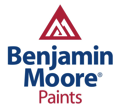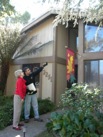Articles to help you learn more about paint Issues and the solutions offered by Paint Pros.
Alligatoring
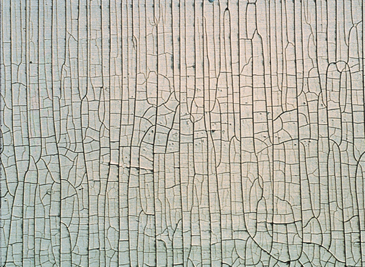
Alligatoring is patterned cracking in the surface of the paint film that resembles the regular scales of an alligator.
What Causes It?
This problem may be caused by applying an extremely hard, rigid coating, like an alkyd enamel, over a more flexible coating, like a latex primer.
Applying the topcoat before the undercoat is dry may also cause alligatoring.
Alternatively, the natural aging of oil-based paints as temperatures fluctuate causes constant expansion and contraction that can result in a loss of paint film elasticity.
How to Solve It
Completely remove the existing oil paint by scraping and sanding the surface. You can use a heat gun to speed up work on large surfaces, but take care to avoid igniting paint or substrate.
The surface should be primed with a high-quality latex or oil-based primer, then painted with a top-quality exterior latex paint.
Note: Images provided by The Rohm & Hass Paint Quality Institute.
Blistering
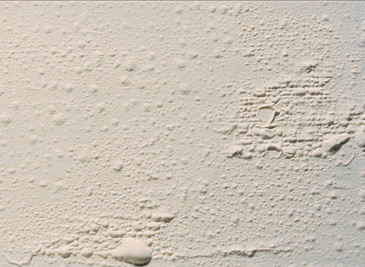
A blister can form when vapor expands between a coated surface and the film that protects it.
What Causes It?
Anything from humidity to construction defects to a lack of effective vapor barriers often can lead to moisture condensation on wood siding, which generates pressure on the wood and its coating. As the surface dries, water evaporates, but the paint film does not recover.
Blisters can also form when painting in direct sunlight with solvent-based coatings on a surface that is too warm. When you apply thicker coats, or re-coat before a previous coat has completely dried, the paint surface can dry before the solvent releases from the underlying film. This traps the solvent, which can expand and cause blisters.
How to Solve It
To remove blistered paint, sand and scrape peeling paint to the bare wood. Prime the exposed areas and repaint them.
For blisters caused by moisture, minimize any future problems by repairing loose caulking and installing vents or exhaust fans. These will allow moisture to evaporate before it can penetrate wood siding.
For large blistered areas, use a high-pressure washer or a heat gun to speed up the process of removing the paint.
Remember that blisters occur only in fresh coats of paint. When they break, they contain no liquid and do not indicate
a defect in the wood. They can be removed by scraping and sanding.
Note: Images provided by The Rohm & Hass Paint Quality Institute.
Chalking
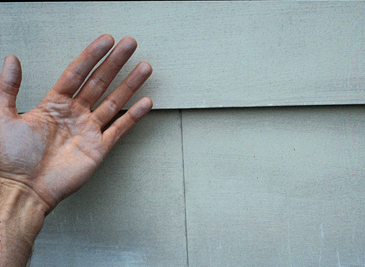
A fine powder can occur on the surface of the paint film during weathering, which can cause color fading.
What Causes It?
Although some degree of chalking is a normal, desirable way for a paint film to wear, excessive film erosion can result in heavy chalking.
The use of a lower-quality, highly pigmented paint or an interior paint can cause the paint to erode prematurely and cause chalking.
How to Solve It
First, remove as much of the caulk residue as possible, using a stiff bristle brush (or wire brush on masonry) and then rinse thoroughly with a garden hose; or use power washing equipment.
Check for any remaining chalk by running a hand over the surface after it dries. If noticeable chalk is still present, apply a quality oil-based or acrylic latex primer (or comparable sealer for masonry).
Repaint with a quality exterior coating. If little or no chalk remains and the old paint is sound, no priming is necessary.
Note: Images provided by The Rohm & Hass Paint Quality Institute.
Chalk Run Down

This problem occurs when the paint film erodes and the resulting residue appears chalky.
What Causes It?
Chalk run-down occurs when paint erodes excessively onto another area below (a brick foundation, for example), ruining its appearance. The problem has a number of causes.
First, the use of a lower-quality, highly pigmented paint or an interior paint can cause the paint to erode prematurely. Factory-finished metal siding can also erode to cause this problem.
How to Solve It
First, remove as much of the chalk residue as possible by scrubbing any stained areas with a stiff brush and a detergent solution. Then, rinse the surface thoroughly. In cases of severe staining, an acid wash may be necessary. Either way, if the affected area dries to a different color, consider painting it with a quality latex paint. Eroding aluminum siding should be thoroughly cleaned (power washing recommended) before painting with a quality exterior latex paint.
Note: Images provided by The Rohm & Hass Paint Quality Institute.
Cracking or Flaking
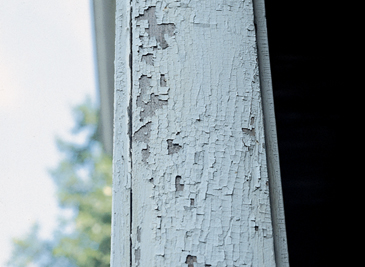
Paint can crack and flake, sometimes revealing the substrate.
What Causes It?
Dry paint can split through at least one coat, which will lead to complete failure of the paint. Early on, the problem appears as hairline cracks. Later, flaking of paint chips occurs.
A variety of causes exist for cracking or flaking of paint. First, if lower-quality paint has been applied to the surface, it will have inadequate adhesion and flexibility. Another cause is that the paint was spread too thin on the surface.
Poor surface preparation, especially when the paint is applied to bare wood without priming, can also cause this problem. Finally, painting under cool or windy conditions can make latex paint dry too fast, causing it to crack.
How to Solve It
If the cracking does not go down to the substrate, you may be able to correct it by removing the loose or flaking paint with
a scraper or wire brush, sanding the area to feather the edges, priming any bare spots, and repainting it.
If the cracking goes down to the substrate, remove all of the paint by scraping and sanding or use a heat gun. Then prime and repaint with a quality exterior paint.
Note: Images provided by The Rohm & Hass Paint Quality Institute.
Fading or Poor Color Retention
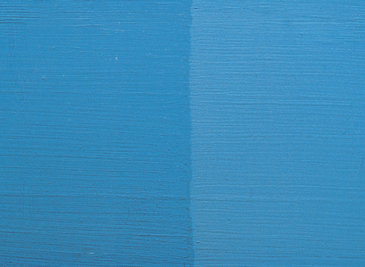
Paint can lighten over time. This occurs on surfaces with sunny southern exposures.
What Causes It?
Fading or poor color retention can also be a result of chalking of the coating. One cause of fading is the use
of an interior grade of paint or lower-quality paint.
This can lead to a rapid degradation (chalking) of the paint film. Some paint colors are particularly vulnerable to UV radiation (most notably, certain bright reds, blues, and yellows).
Fading will also occur when tinting a white paint not intended for tinting, or overtinting a light or medium
paint base.
How to Solve It
When fading or poor color retention is a result of chalking,
it is necessary to remove as much of the chalk as possible. When you repaint the surface, be sure to use a quality exterior house paint in colors recommended for exterior use.
Note: Images provided by The Rohm & Hass Paint Quality Institute.
Lap Marks
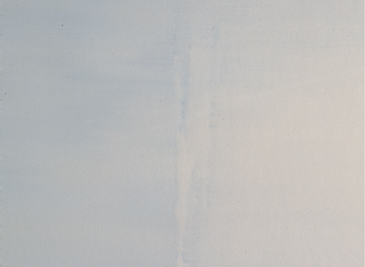
Lap marks appear as a denser color or higher gloss where wet and dry layers overlap.
What Causes It?
Lap marks can occur when wet and dry layers overlap during painting or staining. They can also occur when paint is applied in direct sunlight or in conditions that are too warm, or when paint or stain is applied on too porous a surface.
How to Solve It
To cover lap marks, spread another coat of paint on top of your previous coat, taking care to spread it uniformly. If the finish is transparent or the surface is overly porous, you may need to apply a second coat or a primer coat.
To avoid making lap marks, do not paint sections of large surfaces from top to bottom completely. Instead, paint walls and other surfaces in sections small enough to allow you to maintain a wet edge.
Avoid painting on hot, windy days, as this will accelerate the drying time of paint.
Note: Images provided by The Rohm & Hass Paint Quality Institute.
Mildew
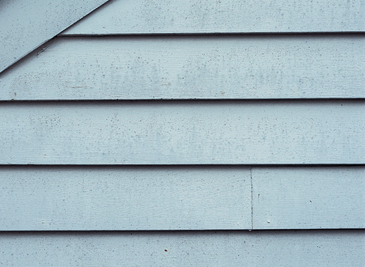
Mildew forms most often on damp areas that receive little or no direct sunlight. It can also form on walls with a northerly exposure, and on the undersides of eaves.
What Causes It?
Mildew is most often caused by:
* Using lower quality paints, which may have insufficient amounts of mildewcide.
* Failing to prime bare wood before painting.
* Painting over a substrate or coating from which mildew has not been removed.
How to Solve It
You can test for mildew by applying a few drops of household bleach to the area you suspect contains mildew. If it disappears, mildew is likely present.
To remove mildew from a surface, scrub it with a mixture of household bleach and water—one part bleach, three parts water. Be sure to wear rubber gloves and eye protection when you do so.
You can also use power washing to remove surface mildew, though you must still use a bleach solution to completely kill the mildew spores.
After cleaning a surface, rinse it thoroughly and apply primer to any bare wood. Then, apply one or two coats of a Benjamin Moore exterior paint, which contains the proper amount of mildewcide.
Note: images provided by The Rohm & Hass Paint Quality Institute.
Nailhead Rusting
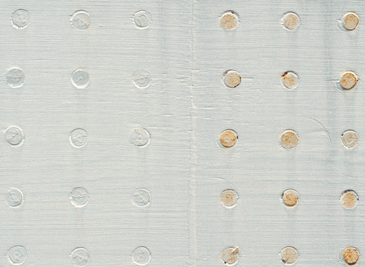
Nailhead rusting appears as reddish-brown stains on the paint surface.
What Causes It?
This problem occurs when non-galvanized iron nails that have not been countersunk and filled over begin to rust, and the rust bleeds through to the topcoat.
Sometimes this condition is caused by galvanized nailheads that have been sanded or have weathered excessively, and they then begin to rust.
How to Solve It
When painting new exterior construction where non-galvanized nails have been used, you should first countersink the nailheads, then caulk over them with a top-quality, water-based all-acrylic or a siliconized acrylic caulk. Each nailhead area should be spot primed, then painted with a quality latex coating.
When repainting exteriors where nailhead rusting has occurred, wash off the rust stains, sand the nailheads, then follow the same surface preparation procedures as for new construction.
Note: Images provided by The Rohm & Hass Paint Quality Institute.
Tannin Staining
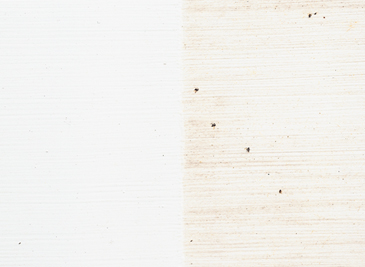
Painting over red cedar, cypress, and redwood can lead to tannin staining.
What Causes It?
Stains from the tannins in these woods are caused by a combination of moisture and insufficient sealing. Moisture can carry tannins contained in the wood through paint on the surface, and are likely to be visible especially with light or medium colors.
How to Solve It - Unpainted Wood
If your wood becomes stained when you are applying paint, use two coats of primer before you apply your topcoat. Be sure to wait 24 hours between coats after applying the first primer coat.
If stains occur, prime the stained spot again and allow it to dry. Then apply the finish coat. In some cases, it is best to allow new wood to weather for several weeks before painting.
How to Solve It - Painted Wood
Wash stained areas with a mixture of denatured alcohol and water. You can also use wood bleach (oxalic acid).
Rinse all treated areas well and let them dry thoroughly, and then apply one coat of your selected primer and topcoat.
Note: Images provided by The Rohm & Hass Paint Quality Institute.
Vinyl Siding Warping
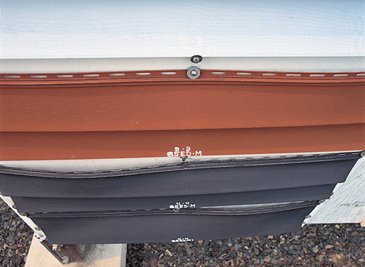
Vinyl siding panels that have been repainted sometimes warp or buckle.
What Causes It?
The most likely cause is that the vinyl siding was repainted with a darker color paint than the original color. Dark paint tends to absorb the heat of the sun, transferring it to the substrate. When vinyl siding expands dramatically, it is not able to contract to its original dimensions.
How to Solve It
Paint vinyl siding in a shade no darker than the original. Whites, off-whites, pastels, and other very light colors are good choices. Top-quality acrylic latex paint is the best type of paint to use on vinyl siding, because the superior flexibility of the paint film enables it to withstand the stress of expansion and contraction cycles caused by outdoor temperature changes.
Siding that has warped or buckled should be assessed by a siding or home repair contractor to determine the best remedy. The siding may have to be replaced.
Note: Images provided by The Rohm & Hass Paint Quality Institute.
Wrinkling
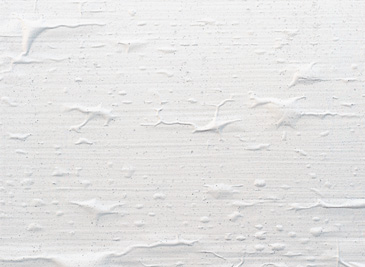
Wrinkling occurs if the paint surface becomes rough and crinkled when the paint forms a "skin."
What Causes It?
Wrinkling can occur when paint has been applied too thickly. This is more likely to happen when using alkyd or oil-based paints.
Painting a hot surface in very hot weather can also lead to wrinkling.
Exposing uncured paint to rain, dew, fog, or high humidity levels can also cause wrinkling.
If you apply the topcoat of paint to an insufficiently dried first coat or to a contaminated surface (e.g., dirt or wax),
it may also lead to wrinkling.
How to Solve It
Scrape or sand the substrate to remove the wrinkled coating. Repaint, applying an even coat of top-quality exterior paint. Make sure the first coat or primer is dry before applying the topcoat.
Apply paints at the manufacturer's recommended spread rate (two coats at the recommended spread rate are better than one thick coat). When painting during extremely hot, cool, or damp weather, allow extra time for the paint to dry completely.
Note: Images provided by The Rohm & Hass Paint Quality Institute.

